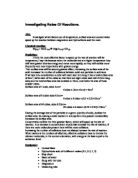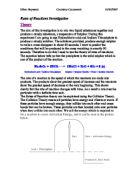Investigating Rates Of Reactions.
Aim:
Investigate which factors out of temperature, surface area and concentration speed up the reaction between magnesium and hydrochloric acid the most.
Chemical reaction:
Mg (s)+ 2HCI (aq)==> MgCI2 (aq)+H2 (g)
Prediction:
I think the most effective factor to speed up the rate of reaction will be temperature, I say this because when the molecules are at a higher temperature they will have greater kinetics energy and move more rapidly, so they will collide more frequently and most importantly with greater energy.
Then surface area will be second greatest effect, increasing the surface area of the solid increases the number of collisions between solid and particles in solutions.
If we take into consideration a cube with each side 1cm long it has a total surface area of 6cm2, halve each of the cubes so that there are eight cubes each with 0.5cm long sides and the total surface area has doubled to 12cm, now halve the size of these smaller cubes.
Surface area of 1 cube, sides 1cm=
6 sides x (1cm x1cm) = 6cm2
Surface area of 8 cubes sides 0.5cm=
8 sides x 6 sides x (0.5 x 0.5)=12cm2
Surface area of 64 cubes, sides 0.25cm=
64 cubes x 6 sides x (0.25 x 0.25)= 24cm2
Having the average size of the particles in a given quantity of solid, doubles the surface area. So making a solid reactant in a lump form into powder considerably increases the surface area.
Aim:
Investigate which factors out of temperature, surface area and concentration speed up the reaction between magnesium and hydrochloric acid the most.
Chemical reaction:
Mg (s)+ 2HCI (aq)==> MgCI2 (aq)+H2 (g)
Prediction:
I think the most effective factor to speed up the rate of reaction will be temperature, I say this because when the molecules are at a higher temperature they will have greater kinetics energy and move more rapidly, so they will collide more frequently and most importantly with greater energy.
Then surface area will be second greatest effect, increasing the surface area of the solid increases the number of collisions between solid and particles in solutions.
If we take into consideration a cube with each side 1cm long it has a total surface area of 6cm2, halve each of the cubes so that there are eight cubes each with 0.5cm long sides and the total surface area has doubled to 12cm, now halve the size of these smaller cubes.
Surface area of 1 cube, sides 1cm=
6 sides x (1cm x1cm) = 6cm2
Surface area of 8 cubes sides 0.5cm=
8 sides x 6 sides x (0.5 x 0.5)=12cm2
Surface area of 64 cubes, sides 0.25cm=
64 cubes x 6 sides x (0.25 x 0.25)= 24cm2
Having the average size of the particles in a given quantity of solid, doubles the surface area. So making a solid reactant in a lump form into powder considerably increases the surface area.







